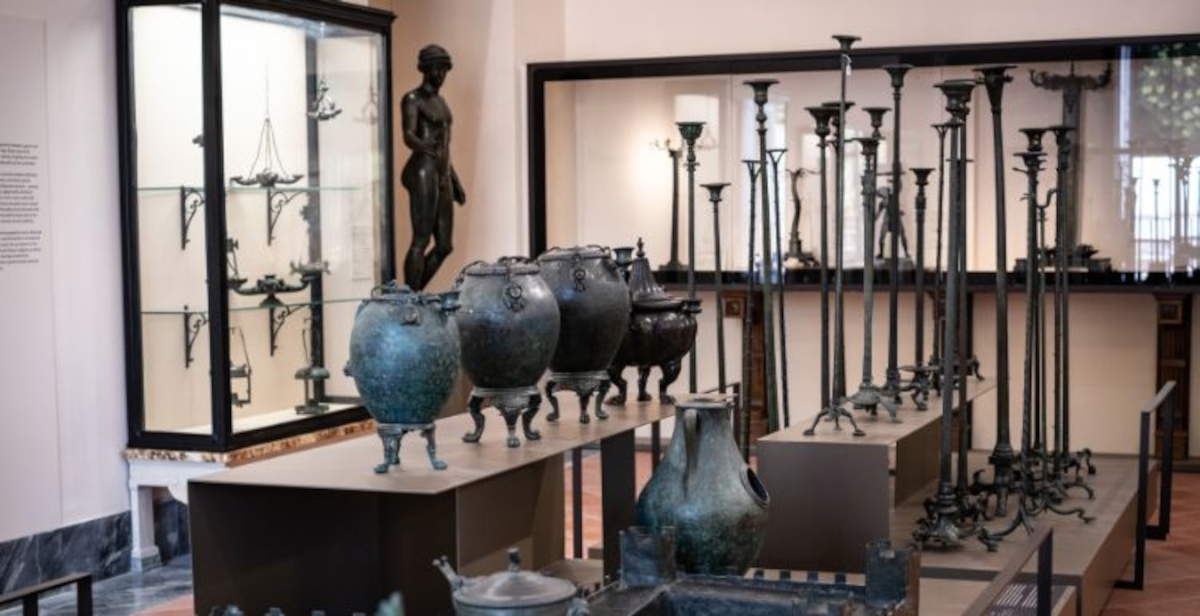The National Archaeological Museum of Naples is enriching its exhibition with a new permanent section dedicated to the furnishings of Pompeian domus. Inaugurated on June 30, 2025, the exhibit entitled Domus. The Furnishings of Pompeii is housed on the second floor of the building and aims to restore, through a wide selection of objects and decorations, the daily atmosphere of the Vesuvian dwellings. The project is curated by Massimo Osanna, Andrea Milanese and Ruggiero Ferrajoli, with the collaboration of Luana Toniolo.
“With this new exhibition we return centrality to the narrative of ancient living,” comments Museums General Director Massimo Osanna, “offering the public the opportunity to enter the Pompeian domus with a renewed gaze. Objects long kept in storage, many of them restored for the occasion, return visible and take on a new voice, telling stories of everyday life, taste and representation. It is a path that combines research, protection and enhancement, to make the museum more and more a living place, capable of welcoming and involving.”


The new exhibition is structured as a path that guides the visitor through the forms of living in Roman times, restoring the symbolic and social significance that these took on within Pompeian homes. Approximately two hundred and fifty artifacts, many of them from the museum’s storerooms and rarely exhibited until now, have been selected to narrate a complex and layered domestic dimension. Furniture, furnishings, decorative elements and objects of daily use become tangible traces of a civilization that attached great importance to the home as a space of representation, a place of family life and a container of beauty.
The selection includes seats, stools, benches, tables, small tables with decorated monopods, braziers, oil lamps, candelabras, food warmers and ceremonial objects, as well as frescoes, sculptures, ornamental fountains and votive pendants. All the artifacts combine to delineate an articulate and multifaceted picture of Pompeian material culture, in which technique, craftsmanship and art coexisted in balance. The variety of materials-bronze, marble, terracotta-and the richness of the formal solutions testify to a taste that profoundly influenced eighteenth- and nineteenth-century Europe, and still offers relevant insights to contemporary design.
Among the most outstanding pieces is a large rectangular brazier finely decorated with copper, tin, and brass inserts. Next to it, a monumental oil holder, embellished with copper and silver ageminate surfaces, features a complex sculptural composition with a young Dionysus riding a panther and a small lit altar, elements that suggest ceremonial use or strong symbolic value. The itinerary also includes a fine folding table, equipped with an intricate locking and carrying mechanism, and a sphinx monopodium table, featuring rich decoration including a crouching sphinx, the bust of Athena, and a bronze frame supporting the marble top.


There is no shortage of evidence more explicitly related to Roman figurative culture. Particularly important is a statue of Apollo, depicted playing the zither, a clear reference to Greek models that were frequently reworked by Roman sculpture. The selection aims to restore the original functions of the works, reinserting them within the domestic context and proposing a reading capable of interweaving art, history and everyday life. The large frescoed walls of the villa of Numerius Popidius Florus in Boscoreale, now restored to improve their legibility, also find new appreciation in the itinerary. The conservation interventions restore greater sharpness to the scenes and colors, allowing the public to appreciate their refinement and compositional complexity.
Also of particular interest is the so-called Hall of the Gryphons, which houses 19th-century furnishings inspired by Pompeian models, now back on view after a long period in storage. The room takes its name from an original table with griffin-shaped feet, displayed together with two large benches, a table and several display case supports made in 1870 at the instigation of Giuseppe Fiorelli, then director of the Pompeii Museum and Excavations. The room is complemented by a copy of Vincenzo Gemito’s famous Narcissus, the original is kept in Room 91, and a selection of graphic materials, including watercolors, engravings and photographs, illustrating the modern reception of Pompeii between the 19th and early 20th centuries.
The introduction to the new itinerary is through a space inspired by the House of the Faun, one of Pompeii’s most famous dwellings. Using digital technologies, visitors can explore the architectural and functional distribution of a Roman domus, understanding the function of the rooms, the logic of their arrangement, and the relationship between public and private space within the house. This is an evocative introduction that prepares for direct observation of the findings, providing interpretive tools and suggesting connections between different levels of the culture of living.


At the same time, the new lighting system for the rooms dedicated to Pompeii’s frescoes was also presented. The project, carried out in collaboration with the company ERCO, allows for a more effective enhancement of the pictorial surfaces, improving the usability and understanding of the masterpieces of ancient painting. The upgrade is part of a renovation of the MANN’s exhibition spaces, which also includes work already underway to refurbish the halls of the Villa of the Papyri.
 |
| At MANN, a new exhibit tells the story of Pompeii's domus and furnishings |
Warning: the translation into English of the original Italian article was created using automatic tools. We undertake to review all articles, but we do not guarantee the total absence of inaccuracies in the translation due to the program. You can find the original by clicking on the ITA button. If you find any mistake,please contact us.